Melanie Zibit
MZibit
Sculpture
- Boston, MA
- zibimela@gmail.com
- www.MelanieZibit.com
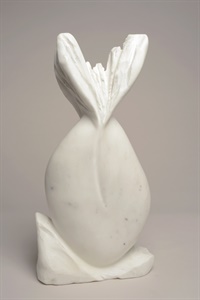
Radish Goddess
Vermont Marble
I am inspired by the beauty of natural forms — from the massive shapes of rocks in the woods to the fascinating curves found in luscious vegetables. ‘Radish Goddess,’ is an abstraction of a radish with sensuously rounded curves, topped by leaves shooting upward in a gesture of life and strength
18"H x 7"W x 5"D
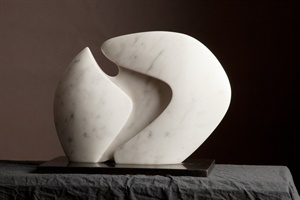
The Dance
Italian marble
Cape Cod Arts Association - Open Juried Exhibit 2015 Received Best Abstract in Show award
Catharine Lorillard Wolfe Art Club 119th Annual Juried Exhibition, NYC
Received the Harriet W. Frishmuth Award, 2015
25"H x 30"W x 6"D
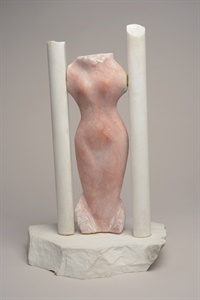
Madona Confined
Alabaster, marble base and marble cores
24"H x 13"W x 8"D
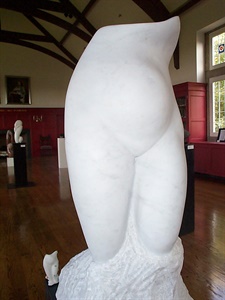
Artemis
ARTEMIS, one of the great divinities of the Greeks. She was the Hellenic goddess of the hunt, wild animals, wilderness, childbirth, virginity and protector of young girls, bringing and relieving disease in women;
Italian Marble
36"H x 24"W x 19"D
private collection
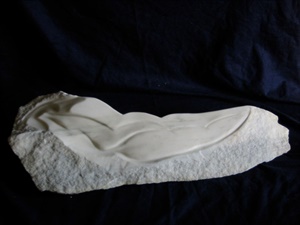
Odalisque
Vermont marble relief
32"H x 11"W x 8"D
Article: Scene & Herd: Sculptor finds heart in stone
Lexington Minuteman Newspaper
By Martha Crosier Wood GateHouse News Service Posted Apr 28, 2011 @ 08:06 AM Last update Apr 28, 2011 @ 07:14 PM
“Sculpting is very, very meditative,” said Melanie Zibit, who works mostly in marble. “When you sculpt you make something that never existed before.”
“My passion is to take stone, something so hard, and make it look soft. One time, just for the delight of it, I carved a marble pillow, enhancing its softness by puckering its marble corners,” she continued.
You can see her work Sunday, 6:30-9 p.m., at the Cary Library Art Sale and Soirée (CLASS3), organized by the Cary Memorial Library Foundation. It's a juried art show, silent auction and community gathering, rolled into one. Works include watercolors and oil paintings, sculpture, glassware, ceramics, polymer clay designs, jewelry, woodcuts, boxes, photography and quilts. Admission is $15 at the door/$12 in advance at Wales Copy Center, Jackson’s Kitchen or the library. Proceeds benefit the library.
“Stone is demanding. Like other things in life worth doing, you have to put your heart and soul into it to do it well. You have to struggle to understand the stone, to slowly move around the block until the form starts to reveal itself. When I work in harmony with the stone, I can make something that is monumental, not necessarily in size but in its lasting expression,” she said.
“I am inspired by the beauty of natural forms — from the massive shapes of rocks in the woods or on the beach to the sensuous forms of the human body to the fascinating curves found in luscious vegetables,” she continued. “My most recent carving is called ‘Radish Goddess,’ an abstraction of a radish with sensuously rounded curves, topped by leaves shooting upward in a gesture of life and strength.”
She likes leaving unfinished elements, inviting you to complete the sculpture in your mind’s eye.
Melanie grew up surrounded by her mother’s love of art and art collection, but she started college studying biology. However, feeling a need to express herself, she transferred to Brandeis trying various art mediums.
“A short introduction to carving was all I needed to know that was my medium! The carving process was meditative and challenging, the possibilities limitless, and the results took on a life of their own as they emerged from a solid block of stone,” she said.
“After college I studied in the marble workshops of Carrara, Italy, learning from the masters,” she said. “Carrara is amazing. There was marble everywhere — even the streets are paved in marble.”
Melanie exhibits in museums and galleries and her pieces are in private collections nationwide. The Middleborough Public Library commissioned her to make “Tree of Knowledge” for its centennial. The 7-foot outdoor sculpture represents literature, arts and knowledge branching out and upwards.
A member of the New England Sculptors’ Association board, she is in Lexingtonian Ashley Rooney’s book “100 Artists of New England.” Melanie moved to East Lexington 13 years ago and now lives on Burlington Street. Her sons, Alex Goldman, 23, a George Washington University senior, and Eben Goldman, 18, a Middlesex Community College student, attended Estabrook and Diamond Middle School. Her “day job” is as a clinical coordinator at Brigham and Women’s Hospital focusing on rheumatology.
Copyright 2011 Lexington Minuteman. Some rights reserved
Review exhibition - Bridgewater State University
By Marc Filippino/mfilippino@wickedlocal.com Lexington Minuteman Posted Jan 31, 2013 @ 10:44 AM
Lexington —
Melanie Zibit was interested to hear an interesting perspective from a Roxbury Latin student during a showing of Zibit’s work in 2002. “The student asked me, ‘Have you noticed that your pieces are really two forms talking to each other?’” said Zibit, reflecting on the event. Zibit’s piece, “Odalesque,” which uses dual elements, was selected by the New England Sculptors Association (NESA) to be featured at an exhibition at Bridgewater State University. The exhibit is on display through March 22, 2013 at Bridgewater State University’s Maxwell Library.
Zibit’s art usually encompasses two separate elements interacting with each other. Her bronze piece “Inner Conversation” uses two abstract pieces that seem to have the back-and-forth of a conversation. Another piece of a reclining nude portrays a set of women’s legs leading up to her buttocks. However, viewed from another angle, the piece appears as if it is a long, hollow shell. Zibit, a self-described three-dimensional thinker, explains the duality of her pieces is a way to portray a relationship between two parts. Her abstracts are meant for the viewer to circle around and view from several different angles. With each new angle, she hopes the person viewing her art sees a new and exciting piece. “It’s a lot like in life, in the way of communicating and living with someone else,” Zibit said. “It’s that way with forms. How do they talk to one another? It adds a lot of energy, but it also adds a complexity.”
While Zibit said she has learned to define her style, she is not opposed to continue learning about herself through her art. For example, she said the comments from the Roxbury Latin student were a learning experience for her. “It opened up a different perspective for me to view and understand my sculpture,” Zibit said. “I’m more conscious of it.”
Zibit said she became interested in sculpting after she transferred to Brandeis College in the late 1960s. After she graduated in 1970, she made her first trips to Italy, where she watched a blacksmith hand carve the sculpting tools that she still uses today. “I use an air hammer, which is more controlled and looks like a large dentist drill,” Zibit said. “But I still use hand tools for the more detailed parts of my pieces.” And detail is key, especially when working with stone. She explains that when working with clay she has the freedom to keep changing her vision through an additive process. But with stone, one wrong move changes everything.
Jay Block, the curator at Bridgewater State University who selected “Odalesque,” said Zibit is a rare example of an artist who excels at both the abstract and physical execution of her work. “Many artist have great ideas and can’t make them into a physical manifestation. Some have beautiful form but don’t have a clue what they are doing,” Block said. “Her work isn’t a mistake. It’s very well done on the conceptual and technical level.” Block said the smooth, round edges of Zibit’s work convey a sensuous nature. He compares her style to that of cave art for its realistic but not overbearing interpretation of the human body. “Cave art is painted and sculpted, and the motion is augmented to have the same level of sophistication as the human form. But it does it with a minimum line and information,” Block said. “Melanie’s work is the same way. It’s not a real hit, but it conveys a body in motion.” Zibit also described her work as sensuous, to an almost erotic sense. “My kids had a hard time growing up with the art,” Zibit said with a laugh. But she said her work needs to have those elements to have the important message she hopes to convey. “The human form helps us connect with who we are,” Zibit said. “There is something very powerful about a life that is related to sensuousness.”





